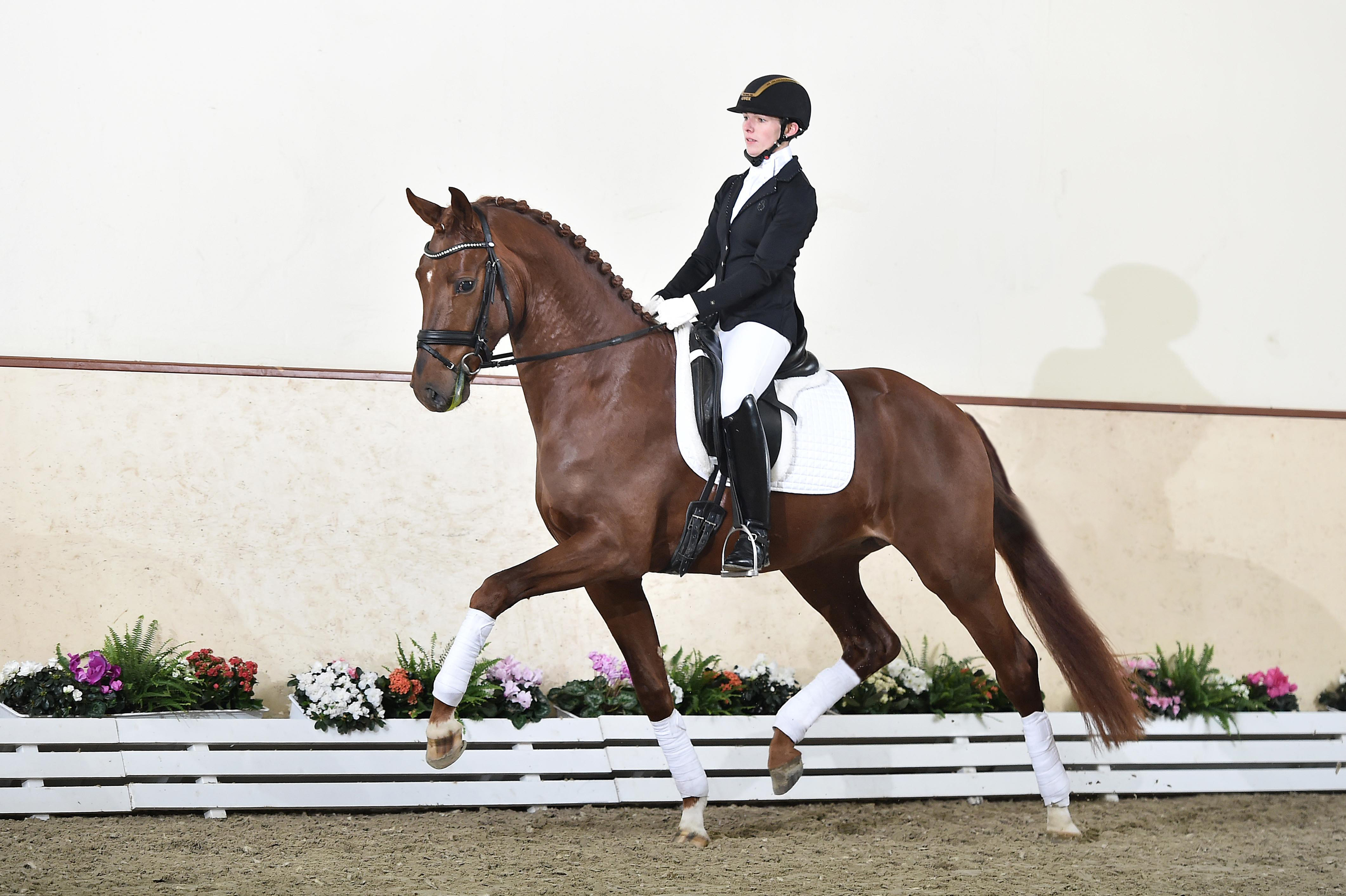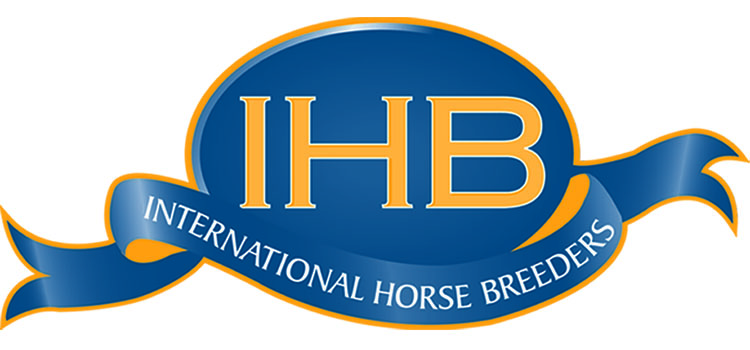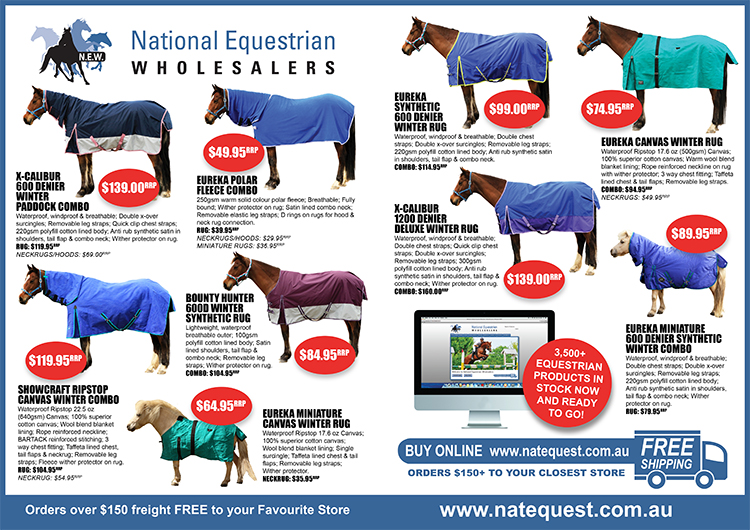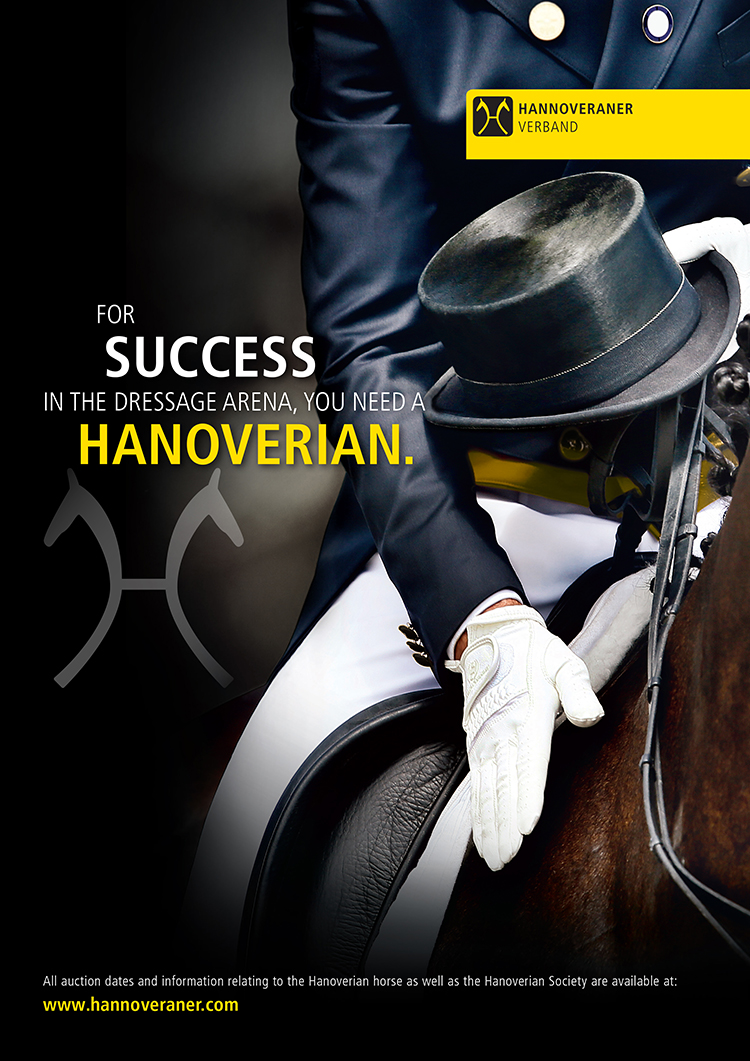As a group, we in the Australian dressage community, have a well-deserved reputation for being easily won, we tend to fall madly, head-over-heels in love with the latest pair of shiny black boots just off the plane… Alas most of these whirlwind affairs end in tears. But this time with Steffen Peters, this – as they say on the soaps – is different. And hopefully it is not some passing infatuation, but the beginning of something big and lasting. And wonderful.
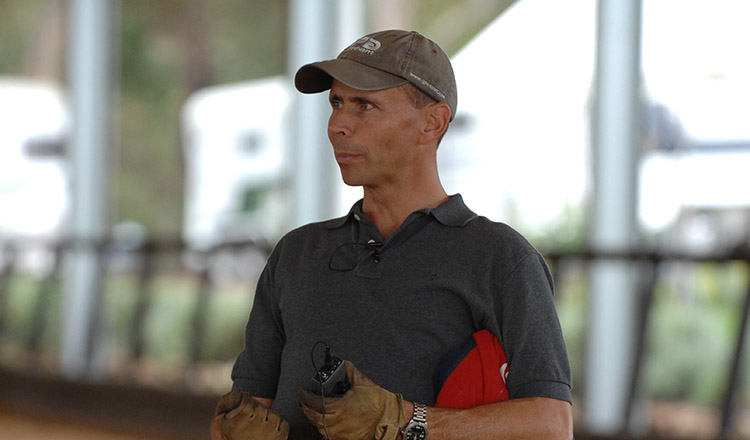 So what is so different about Steffen Peters?
So what is so different about Steffen Peters?
For a start Steffen is a brilliant teacher with a subtle multi-layered awareness of exactly what is happening between horse and rider. Many times he would be suggesting the correction before the problem became apparent. He was happy to work with the rider in tackling their hardest problems, rather than just working the things that make him look good as an instructor.
He is also an exceptional communicator and does so in the quietest, most reasonable of tones. His voice is relaxing and reassuring, even if what he is communicating is electric and stimulating. He is working on building the rider’s confidence all the time…
Steffen’s philosophy is the ultimate in horse friendly training. Again, while he was as demanding as all-get-out, he was never confrontational, not when he was teaching, not when he was riding.
Steffen is a rider, an international rider, who has produced a string of top Grand Prix horses and is still competing at the highest international level. He is also a German who has spent the past 22 years in America, and he is used to dealing with riders from a non-German background.
I know we’ve lost our hearts before but… It’s a little hard to know where to begin so let’s begin at the clinic Steffen held before the master class, and later we’ll see how it all came together at a show that set new standards in the master class stakes…
It should be said that Steffen benefited from working with an exceptionally talented group of horses and riders.
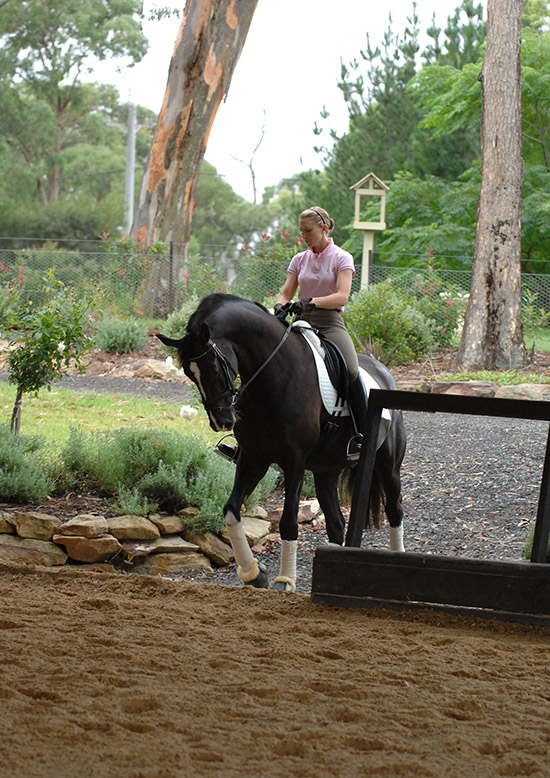
The first lesson I saw was with Kate Taylor-Wheat and her five-year-old imported Hanoverian, World Star (by the Warkant son, World Magic). Last year, ‘Sox’ won the NSW Novice Horse of the Year title, with a percentage best of 89.6%.
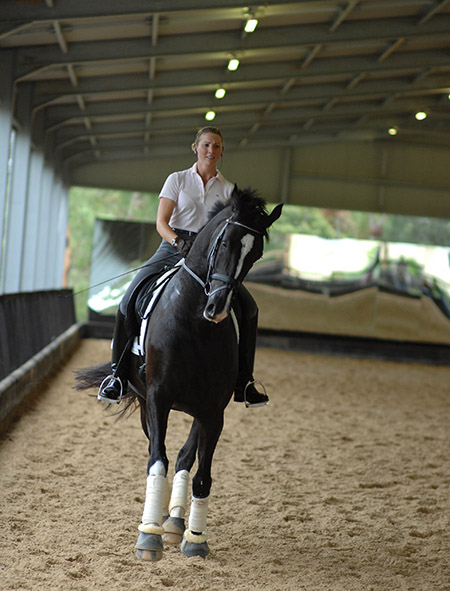
In an era where it is fashionable to have horses running wildly around with their heads between their knees (‘getting them over the back’), Steffen’s response is individual and subtle – yes, he is allowed to go a little deeper, but not pull down, “it must be a very controlled stretch, there is a fine line between pushing to the hand and getting his hind legs and him getting too strong.”
Like most of our horses, World Star has been stuck at home with the dreaded EI and coming to an exciting new place, gets to him. He just wants to do a couple of little leaps in the air…
“Is that normal?” Steffen asks, “Just keep him on the circle, flexed a little bit.” This is followed by another little rear and leap, and the slightly anxious enquiry:
“Is that usually all he does, or is there a little more in there?”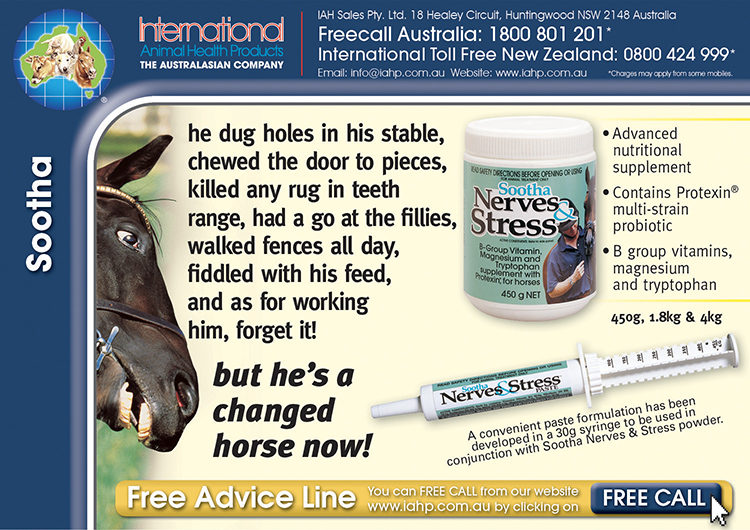
Sox relaxes, Kate relaxes, Steffen is ultra focussed: “Round is fine, but make sure it is not an evasion, if he takes his neck down inch by inch as you give to him, that’s OK, as long as he is not pushing down – let’s try the whole arena and see what he does…”
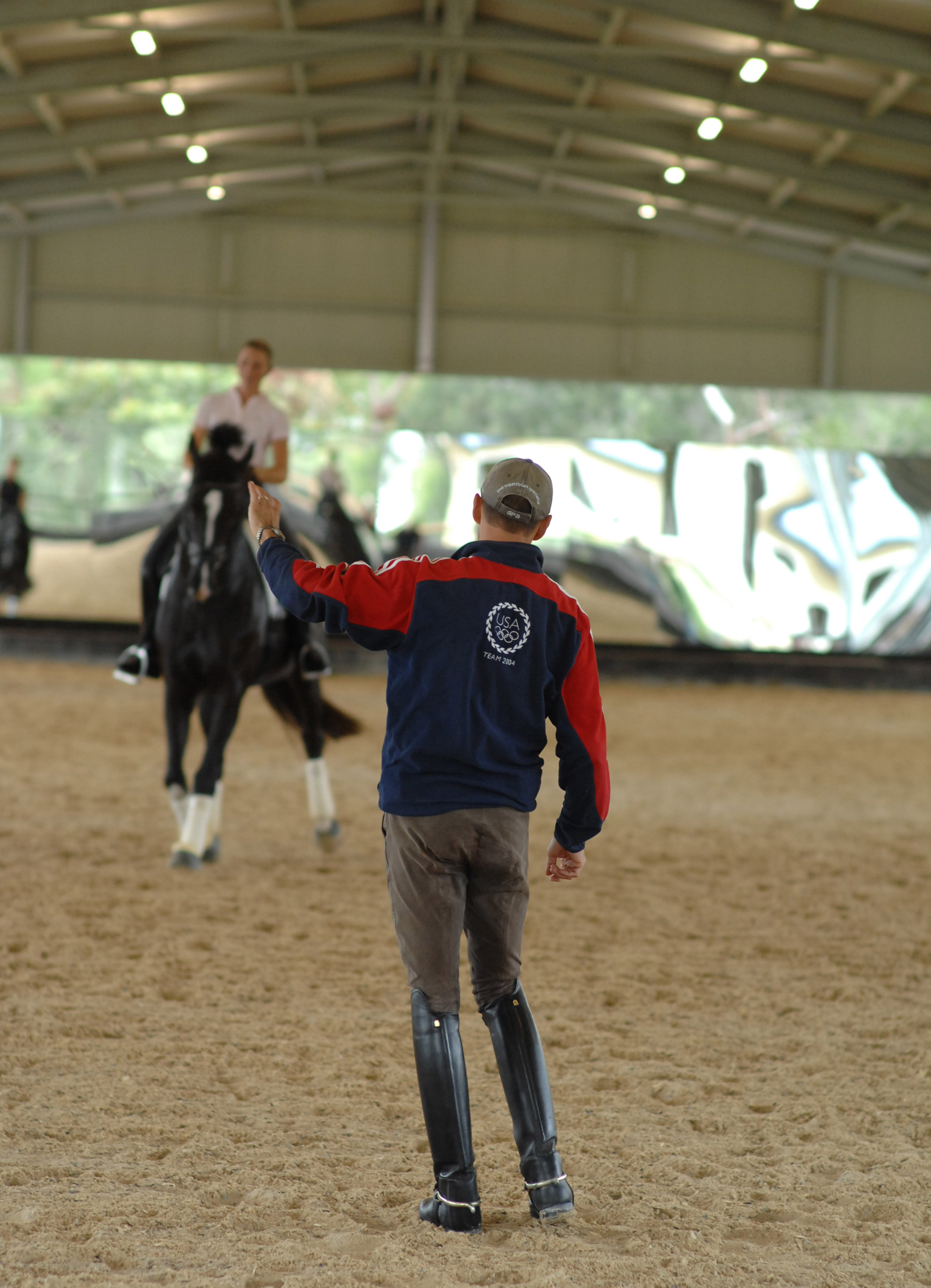 And, this is a constant theme in Steffen’s teaching, use a little flexion to alter the frame and test the quality of the work: “Give him a little counter flexion to the outside…”
And, this is a constant theme in Steffen’s teaching, use a little flexion to alter the frame and test the quality of the work: “Give him a little counter flexion to the outside…”
Steffen and Sox working on counter flexion
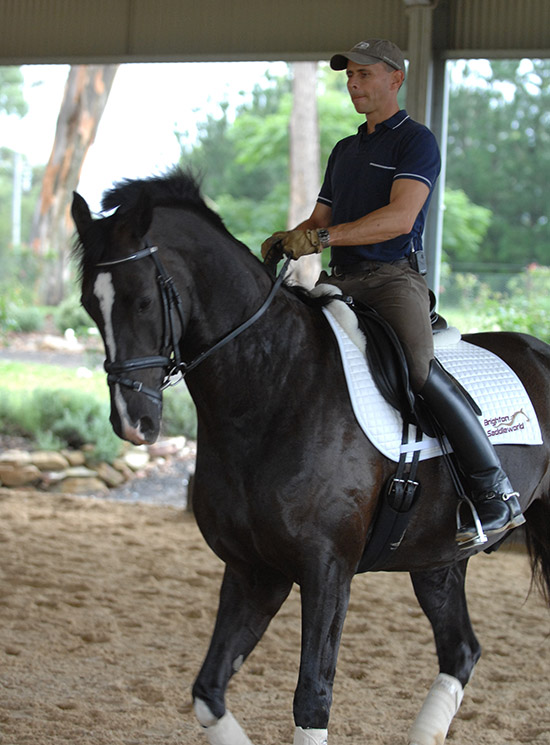
It’s the same in the canter, Steffen is happy to see a big uphill canter, but once again, the horse must only lower his neck when he is asked to, and only as much as he is asked to.
If there is an emphasis on flexion, it’s an equal emphasis on straightness: “I love his gaits, but make straightness a big part of your work every day, use shoulder fore, but also a little leg yielding to make him 100% straight.”
Steffen is also working on getting the horse to go forward and back, oh yeah you say, we’ve heard that one before, but this is really forward, and really back, what Steffen calls ‘pirouette canter’. But the rider is to make her demands subtly – ‘make sure every correction is in his comfort zone, so he doesn’t lose confidence.’
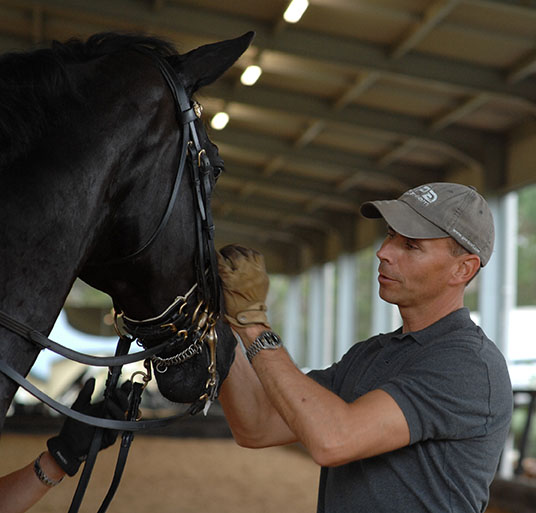
Steffen also wanted a longer aid: “Instead of kicking for a tenth of a second, close and hold for a second, use a tiny bit longer driving aid… We want an immediate reaction from your whole leg, a reaction from your knee and thigh, not your lower leg.”
Next walk time for the horse – no relaxing to the rider…
It’s relaxation time for the horse – walk time – but there’s no relax time for the rider, the walk on a long rein has to be a perfect walk on a long rein. “Bring his neck up a bit, his nose out a bit, more forward. Every time you walk, make the frame of an extended walk, with his neck parallel to the ground, and the nose slightly forward. Every time you take a break, instead of a loose rein walk, make sure it is a walk in the frame of extended walk, manifest a positive habit. That’s much better, praise, praise.”
Then it was back to canter to see if the canter work would improve the trot: “Try that pirouette canter again, then ask yourself, can I use that extra engagement in trot? If he learns to come back to you on a straight line, then you learn perfect engagement.”
It was time to work on the changes, but again, the aim was to train, not to show off the changes, so if the horse was not quite straight, there was no point in asking for a change:
“Every mistake is a training opportunity. If he goes a little crooked, I’m going to circle him two or three times so he knows it is not acceptable…
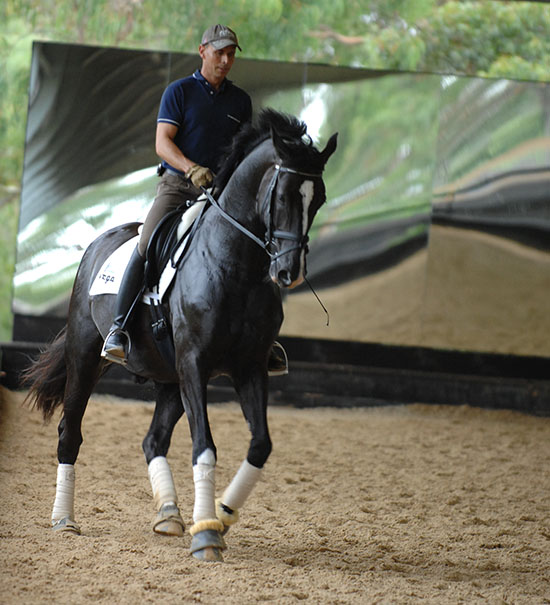
At every point, Steffen was talking about quite simple things, things we think we pay attention to, but don’t… Every transition was a major test:
“Try to have a little higher expectations in the transition. He could respond quicker, If he comes behind the leg, create the sensitivity, he needs to know that the leg is the gas pedal…”
Once again, it was time to pat, time for a walk, but that walk had to be for a 9!
I should stress at this point, that all Steffen’s remarks were made ever so quietly into his mike linked to the rider’s headset. If you sat right next to him, you could just hear what he was saying and he never once raised his voice. It meant that the rider came out of the arena full of confidence, looking forward to the next working session…

Later I caught up with Kate and asked her about her big – that’s 17.2 big – Hanoverian…
“He’d just turned three, the day I bought him, just passed his stallion test, and I brought him home in 2005. But he was a bit stalliony so we had to geld him. He was too big to be a stallion! He had a few problems with the gelding and ended up having eight months rest, so he hasn’t done a lot.”
“He’s done just three competitions and very well…”
But he has already started to do a few short steps, half pass?
“He just finds it easy. You get on and you say, let’s try this today, and he does it – better than my Grand Prix horse. He’s very talented.”
Was that a bit of a surprise today when you got on and found he wanted to join the wild west show?
“Yeah – he’d never done that. I totally forgot he’s only done three comps in his life and he hasn’t been out since August… what can you do, they are young horses, but I think I’ll lunge him at SIEC before the Master Class.”
That was a nice subtle lesson you had with Steffen?
“He’s so calming, no stress, if you have a mistake it doesn’t matter just keep going, even a mistake he turns into some training aid, which is perfect because then when you are at home, you can turn mistakes into positives. It’s good for young horses, they don’t get afraid and upset.”
You were mainly working on straightness?
“I think because he has such a big stride, he tends to be crooked so he doesn’t hit his front feet. I think once he gets stronger and takes more weight behind, the straightness will comes as well. We are really working on straightness and connection, it was perfect, just what he needs.”
And stopping him running away by going too deep…
“They like to evade, it’s an easy way out, so they go deep…”
Kate has been riding since she was 13. She started riding dressage with Judy Dierks and rode with her for six years. Then she spent four years with Matthew Dowsley and now she is working with Roger Fitzhardinge. She is very excited about entering Grand Prix ranks with her other horse, Oscar B: “I trained him from Novice to Grand Prix, that’s really exciting…”
Next rider to come was Nadia Coghlan
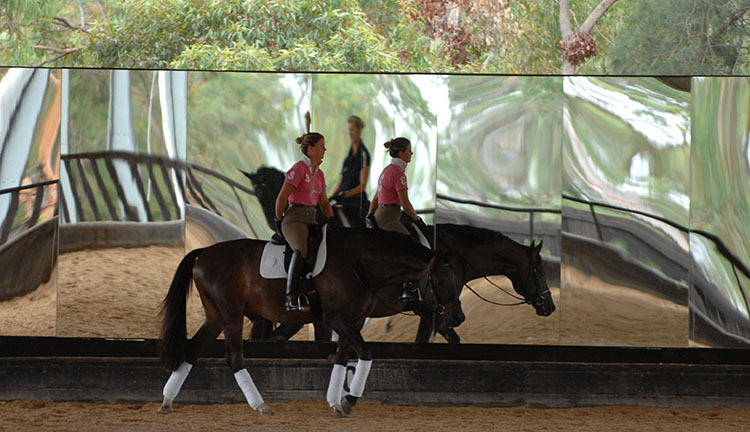
The next horse into the arena was another import, the eight-year-old Carlyle, purchased by Nadia Coghlan in Germany when he was a four-year-old. Nadia took Carli to the World Young Horse Championships, and now they are competing at Prix St Georges level, that is, when we get to compete again…
Once again, the dreaded dive: “Careful Nadia, he is pressing down. Yes we have to get the horse over the back, but make sure it is not evasive.”
“Ask for a little flexion, even though he is very elastic, he has to let go more. It’s important to flex to the right and to the left, there must be no compromise in the warmup. Flex and release.
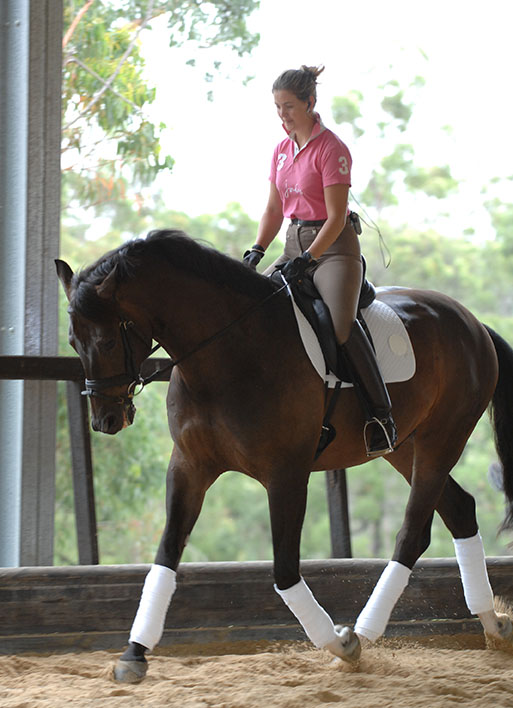
Does he immediately go straight? When you release he should go two or three steps still with the bend, otherwise he will trick you into holding the inside rein. We don’t want him too low, we want him a little rounder in the poll. Flexion in the poll is as important as loose over the back. Every inconsistency in the contact has to be addressed in the beginning – soft but solid contact.”
And now another theme, whatever you start, you have to finish.
“Whenever you start a half halt, finish it 100%, and release 100%. Don’t let him trick you into anything in between. We are not just warming up his muscles, we are getting his attention. Don’t let him trick you into too much contact. He is allowed to go into your hand, but not an ounce more. Never cover up in training, never one stride with too much in your hand. One ounce too much will build up too much tension; shorten the frame creating the reason to let go of the rein. Don’t accept that when you engage him, he becomes more rigid – bend him in, bend him out, test if the suppleness can match the engagement. Make him looser when you collect him. When I collect, can I keep him supple? If you don’t test him, he’ll test you. Expose him to a touch more suppleness in extension and collection – a little more throughness. If you don’t ask for throughness you won’t get it.”
“Set your standards higher for suppleness, it all comes down to your expectations. Collect 100%, release 100%, 100% round, release 100%. It’s okay if the rein gets loose. The Germans don’t like that, but it is okay. Set him on his hindlegs first, and then ride the lengthening.”
“Be picky because for the next level you need 100% self carriage. If the horse is expressive without perfect control, then there will be problems in the Grand Prix. You can compromise on expression but never compromise on suppleness.”
This was something Steffen did over and over again with all the riders, at every point the horse had to be supple, it had to be letting the aids go through, or all the flamboyant movement in the world, was worth nothing.
And every movement, simply every single movement, had to be ridden to the max:
“That transition was a 6. If you let it be a 6, it won’t change. Do it again, better. Look for positive reactions not negative habits.”
But keep it supple: “Don’t be afraid to ask for a little outside flexion, a little inside flexion, loosen the gait. The horse has the most wonderful movement but it is not worth anything is he loses the suppleness.”
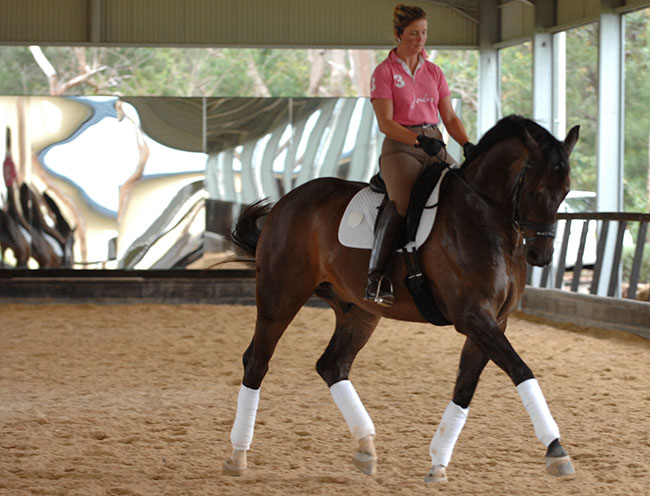
Nadia’s horse liked to throw himself into the canter pirouette, making it smaller to make it easier, Steffen was having none of it: “Make it very clearly a travers movement. Long side in travers, and when you turn to go to the pirouette, keep the angle through his body. Now a ten metre half circle, haunches in, keep it very controlled, very consistent, now five metres, haunches in. Don’t let him take over and make smaller. You never have to worry about him not coming under, he has a wonderful talent for collection, but if he comes under, does he become rigid? Rideability is the bottom line, you can’t be in charge if he is not supple enough.”
“Ride a true pirouette, not with him falling through your inside leg. Large, large, large – school the pirouettes. Don’t let him tip you forward. Don’t let it bug you, stay positive, stay centred with your seat, stay back, don’t give him the chance of an evasion.”
“The more he is listening sensitively to your outside leg, the easier it is for you to sit to the inside. After he reacts to your spur, push your heel down and make sure he is listening to your calf. The spur is your emergency aid. Our goal should be to get it done from the calf.”
It was interesting when Steffen rode the horses, and they learnt that every leg aid was not accompanied by a ‘touch’ of the spur, that he was able to carry on a very subtle dialogue with the horse through his legs…
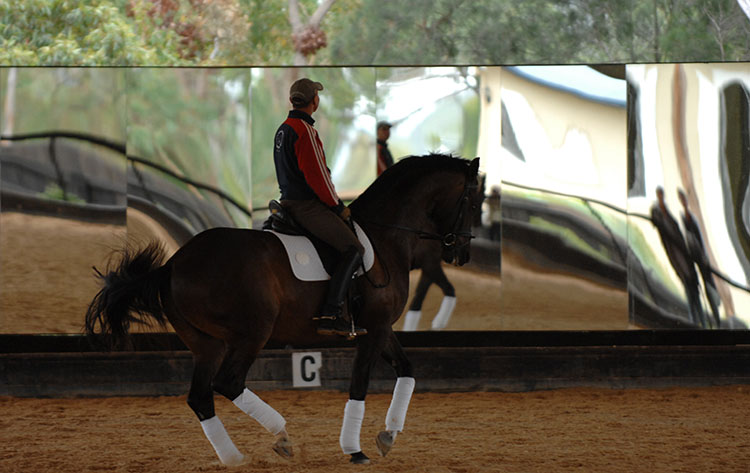
And like Kate, Nadia had to ride every ‘relaxing’ walk for the maximum marks: “Ride it every day, extended walk, create a habit, horses can relax in extended walk. Extend the walk and he starts reaching from hips and stifle, and you loosen him up. He can relax and get oxygen into his muscles but still respect your aids while he is walking. Remind him, the aids don’t support him.”
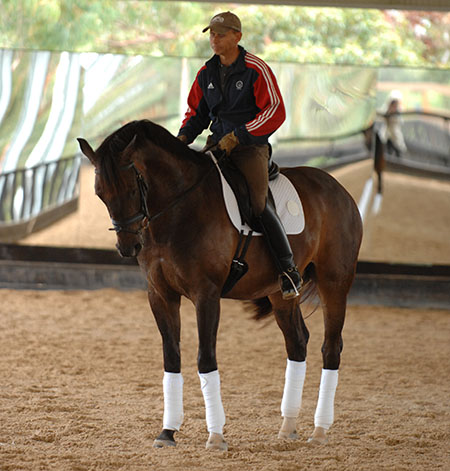
Always, the rider had to set the framework, in canter, Nadia was reminded: “Careful, he’s getting too long and rigid. Get him away from your hands. The horse should go to your hands, but there should be a limit.”
And in case you were wondering if Steffen could walk-the-walk, he pops on Carli and extracts some truly wonderful piaffe.
When Nadia gets back in the saddle, Steffen is still not happy with the contact: “Just keep watching the contact. Finish the half halt all the way. The problem starts in halt, don’t ever let him walk on until you ask him to. There is a fine line in the canter – round enough but not too deep. Flexion in the poll, but not at the base of the neck. The contact you have there, I would use to ride a halt. Get him more back, more on his hind legs, then release him. Keep him supple through the top line, there is no need to accept this, he is way too clever! Flex him and get him more supple, not more expressive, more supple. I know he can do a huge canter extension, or a trot extension, I’m not interested in that – you have to be in control, stay in charge.”
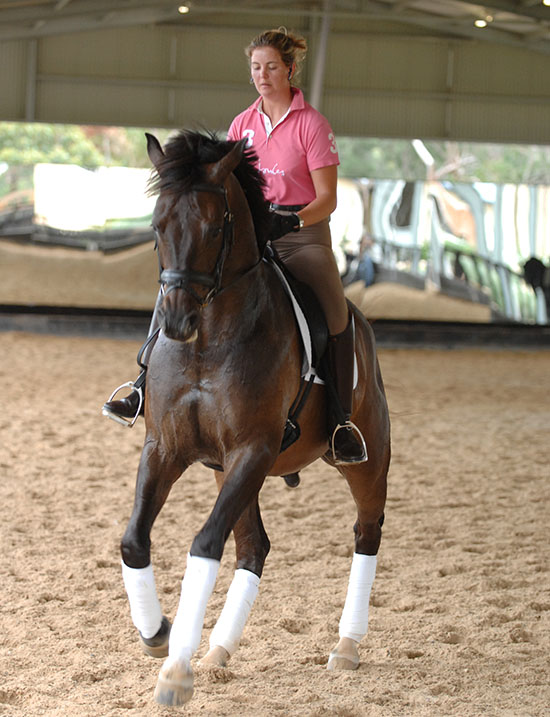
“I don’t care how obvious a half halt is, the giving aid has to be just as obvious. Lots of instructors say ‘don’t use your hands’, then they get on, and they use them even more – sometimes you have to for a few moments. Let the rein get loose after the half halt, teach him to stay away from your hand.”
Nadia was riding a schooling pirouette, again the issue was contact: “Be careful, you have a ton in your hand, create the situation where you can give. Keep a playful contact. If there’s too much in your hand, don’t accept it, make the horse rounder, so you can give.”
It was the same in piaffe: “Increase the suppleness, don’t just hold in front – better, right away he’s more active behind. When you get him soften in your hand and you make him let go, he will be quieter in the mouth. He’s super, but don’t let him think he’s a big horse, let him think he’s a small horse; there’s no need for him to be a bully. The most important part of his body is not his hind leg, not his back, it’s his brain, get that and he’ll learn to use his muscles to carry you, not against you.”
It was the same in the flying changes, once again, the canter had to be perfect: “In canter, not a stride against your hand, not a stride against your leg. Get him more cooperative so we can ride him more passively.”
And when the first change is a bit messy – “Do you want to work through it? Do something more basic. More snaffle rein, when you make him rounder, you use too much lower leg, use a holding leg. Use your whole leg, close your leg, rounder in the poll not lower in the neck, and yes, after the flying change, a forward driving aid. It’s really two aids – change and forward.”
Let’s try some half pass: “Easy on the sideways, think more about suppleness.”
And piaffe: “Put your heels down, don’t use the spur. Let him quit once, then push forward. He should not think that piaffe only happens when you use spur. Circle, bring the horse back with your seat and your rein, and when your legs are near him, that’s when he is more active…”
And yes, “there is no need for him to dive when you go to rising trot…”
Like Kate, Nadia enjoyed working with Steffen:
“I found the lessons really really good. He catches the horse when they want to rest on your hand, and he says you have to catch them before that, and get them away from that kind of thinking. My horse Carli was much better in the hand as a result – not taking over. Waiting, and not trying to rush ahead, it’s such a good feeling.”
“You are always thinking when you are riding, every stride, making sure the horse is listening to you not getting ahead of you. He is not here to show off the horses, it’s the basic work and making the paces that much better. Everything more relaxed, flowing…”
“Carli loves to dive down and push on the bit, and Steffen saw that as soon as I walked into the arena on the first day. He said, get him away from the bit, you want them over the back and reaching, but you don’t want him pushing into the hand and being aggressive. Lots of half halts, but then giving all the time, making sure that the horse is independent.”
It’s all stuff that we know, know the words, but don’t do it…
“We forget. You let the horse get away with it a few times too often and that’s when the problems start – the submissiveness, that’s what I worked on a lot. He can do all the tricks, but you have to make them wait. There’s no point in showing off the tricks, if the basics aren’t great, and the submissiveness not there, it’s never going to be as good as it could be. He said I could probably pull it off with Carli because he’s got that big movement, so that even if he is a bit on the forehand, he’ll still look great, but he’ll a hundred times better when he is really listening and off the hand and working with you…”
Steffen Peters – The Early Years
German born Steffen Peters actually started his riding career in Holland:
“It all started with a little weekend house, a vacation home that Mom and Dad had, near the Dutch border. My sister started to ride ponies and took me a long one day. Two or three years later, Mom and Dad bought us some ponies – they didn’t know anything about horses but they happened to buy two pretty decent ponies. Mine was a jumper and my sister’s was a dressage pony. You can compete until you are 16 on ponies over there, and they have European championships for ponies, it’s like a big international circuit, even before Young Riders. So at 14, 15, 16, we did some international shows.”
“When I was sixteen, Dad purchased a three year old horse. This was the second time we got a little lucky, this three year old turned out to be Udon, who I rode in the 1996 Olympics. At that time nobody knew the horse could be a Grand Prix dressage horse – he was a Dutch horse by Darling Boy. At that stage I was still doing some shows in Holland, and I was invited to ride for Jo Hinnemann in Germany. I was accepted there and stayed from 1980 to 1985 at his barn and learned and trained there. It was there in 1984 when I met Laurie Falvo, a trainer from San Diego, and she invited me to work for her in the States. I did that in the summer of 84, then went back to Germany to do my Army Service, until August of 85. I was released on August 30, and by September 1, I was in the States and I knew for sure that was the place I wanted to be.”
“ I was in the right place at the right time, because dressage was very much growing in the States. I had another huge break in 1991, when one of my sponsors, still a current sponsor, came up and said they would like to purchase Udon, and have me train the horse. Those things happen probably once every hundred years. So my family sold Udon to the Kommerstads. This was 1991 when I started my own business, and that was the beginning of my Grand Prix career. I rode my first international Grand Prix in 1993 in Rotterdam, and things evolved from there.”
“At that time I saw myself more as a competitor, but I always enjoyed the teaching part, mainly because in Germany you have to figure out a whole bunch of things on your own – at least in the school I came from – and I always thought it would be really interesting to go into the detail, to talk about particular aids, particular exercises that improve the horse and the rider, and that is where I started to enjoy the training part… that’s where the clinics evolved from. I think the clinics were where I met a lot of new sponsors… who then bought horses that became internationally successful.”
ADVERTISEMENT
Looking at breeding your own dressage star? International Horse breeders have a wide selection of Europe’s top stallions available in Australia Go to clickhttp://www.ihb.com.au
Like Fursten Jazz
